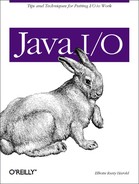Objects are serialized by object output
streams. They
are deserialized by object input streams. These are instances of
java.io.ObjectOutputStream and
java.io.ObjectInputStream, respectively:
public class ObjectOutputStream extends OutputStream implements ObjectOutput, ObjectStreamConstants public class ObjectInputStream extends InputStream implements ObjectInput, ObjectStreamConstants
The ObjectOutput interface is a subinterface of
java.io.DataOutput that declares the basic methods
used to write objects and data. The ObjectInput
interface is a subinterface of java.io.DataInput
that declares the basic methods used to read objects and data.
java.io.ObjectStreamConstants is an unimportant
interface that merely declares mnemonic constants for “magic
numbers” used in the object serialization. (A major goal of the
object stream classes is shielding client programmers from details of
the format used to serialize objects such as magic numbers.)
Although these classes are not technically filter output streams,
since they do not extend FilterOutputStream and
FilterInputStream, they are chained to underlying
streams in the constructors:
public ObjectOutputStream(OutputStream out) throws IOException public ObjectInputStream(InputStream in) throws IOException
To write an object onto a stream, you chain an object output stream
to the stream, then pass the object to the object output
stream’s writeObject() method:
public final void writeObject(Object o) throws IOException
For example:
try {
Point p = new Point(34, 22);
FileOutputStream fout = new FileOutputStream("point.ser");
ObjectOutputStream oout = new ObjectOutputStream(fout);
oout.writeObject(p);
oout.close();
}
catch (Exception e) {System.err.println(e);}Later, the object can be read back using the
readObject() method of the
ObjectInputStream class:
public final Object readObject()
throws OptionalDataException, ClassNotFoundException, IOExceptionFor example:
try {
FileInputStream fin = new FileInputStream("point.ser");
ObjectInputStream oin = new ObjectInputStream(fin);
Object o = oin.readObject();
Point p = (Point) o;
oin.close();
}
catch (Exception e) {System.err.println(e);}The reconstituted point has the same values as the original point.
Its x is 34 and its y is
22, just like the Point object that was written.
However, since readObject() is only declared to
return an Object, you usually need to cast the
deserialized object to a more specific type.
Both writeObject() and
readObject() throw IOException
for all the usual reasons an I/O operation can fail (disk filling up,
network connection being severed, etc.). The
readObject() method also throws
OptionalDataException if the stream doesn’t
appear to contain an object in the proper format or a
ClassNotFoundException if a definition for the
class of the object read from the input stream is not available in
the current VM.
